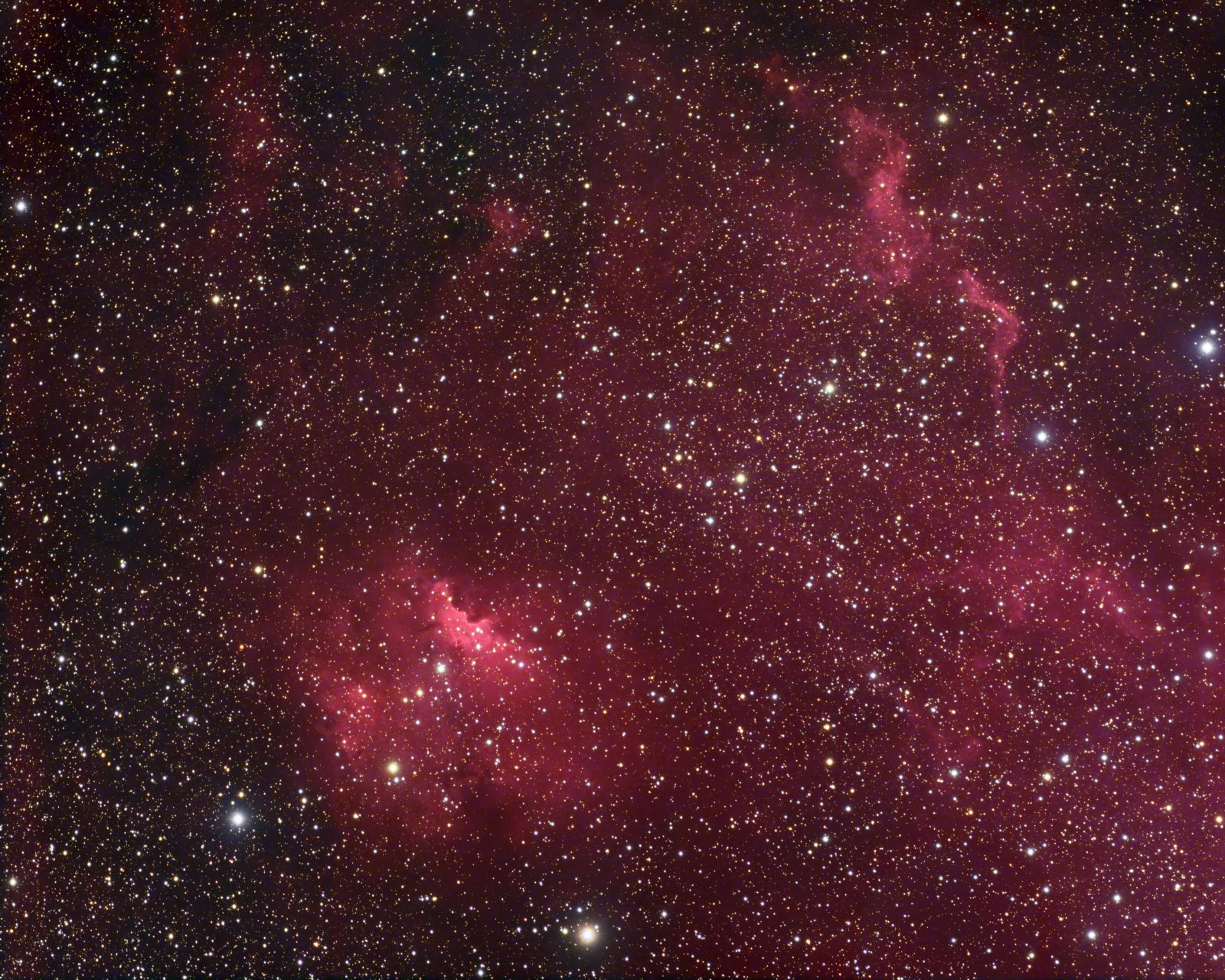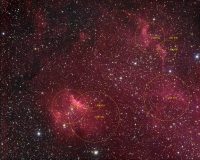Sh2-135
 Click image for full size version
Click image for full size version
September 5, 2022
Sh2-135 is the largest and brightest nebula in this field, which lies in Cepheus, approximately midway between the Bubble Nebula and IC1396. I have shot this region before in a wider field, but wanted more detail so I used a longer focal length this time. The estimated distance to Sh2-135, similar to most of the Ha regions in this part of the sky. There are many other catalogued objects in this image. See the annotated image for information.
Tekkies:
Acquisition, focusing, and control of Paramount MX mount with N.I.N.A., and TheSkyX. Focus with Optec DirectSync motors and controller. Equipment control with PrimaLuce Labs Eagle 4 Pro computer. All pre-processing and processing in PixInsight. Acquired from my SkyShed in Guelph. Very good transparency and average seeing. Acquired July 8-11, 2022, under moderately bright skies.
Sky-Watcher Esprit 150 f/7 refractor and QHY16200A camera with Optolong UV/IR filter
Tak FSQ-106 @ f/5 (530mm), QHY-367C Pro One-shot colour with Optolong UV/IR filter
50 x 5m Lum = 4hr10m
129 x 5m Ha = 10hr45m
170 x 5m OSC = 14hr10m
Data Reduction and Initial Processing
Preprocessing: The WeightedBatchPreProcessing script was used to create Luminance and H-alpha master frames from the mono camera and an RGB master frame from the one-shot colour camera. DrizzleIntegration (2x CFA Drizzle) was applied to the RGB and Lum sets. The RGB and Ha masters were registered to the Luminance master using StarAlignment.
Gradient Removal: DBE was applied to each of the three masters using Subtraction.
Colour
Colour Calibration: ColorCalibration was used to calibrate the OSC master.
Linear Noise Reduction: NoiseXterminator was used to reduce noise in the background areas with settings Amount=0.9 and Detail=0.15
Stretching: HistogramTransformation was applied to make a pleasing yet bright image.
Luminance and H-alpha
Deconvolution: A star mask was made from the Luminance master to use as a Local Deringing Support Image. A stretched clone of the H-alpha image was used to make a mask selecting bright regions of the nebula for deconvolution. Deconvolution was applied (30 iterations, regularized Richardson-Lucy, ParametricPSF mode with default settings; Global dark deringing = 0.02; Global bright deringing 0.007).
Linear Noise Reduction: NoiseXterminator was used to reduce noise in the background areas with settings Amount=0.9 and Detail=0.25
Stretching: HistogramTransformation was applied to make a pleasing yet bright image.
Combining Luminance, Colour and Ha Images
Luminance addition: LRGBCombination was applied to replace the lightness of the RGB image with the Luminance master.
Star Removal: StarNet v2 was used to remove stars from both the LRGB and Ha images.
H-alpha Blending: PixelMath was used to add the starless H-alpha to the starless LRGB image (the target image, $T), using the following expressions for the R, G and B channels:
R: max($T[0], 1.2*Ha)
G: $T[1]
B: iif($T[0]<Ha, $T[2] + 0.06*Ha, $T[2])
Additional Processing
Nonlinear Noise Reduction: NoiseXterminator was used to reduce noise in the background areas of each image with settings Amount=0.9 and Detail=0.25
Contrast Enhancement: LocalHistogramEqualization was applied using an inverted lightness mask to protect the background and select the galaxies. Three passes were applied (scale 20, max contrast 1.5, strength 0.5, 1 iteration; scale 50, max contrast 1.5, strength 0.3, 1 iteration; and scale 100, max contrast 1.5, strength 0.25).
Sharpening: MultiscaleMedianTransform was used with the same mask used for Deconvolution to sharpen Layers 1 – 4 with strengths of 0.05, 0.2, 0.1 and 0.05, respectively.
Star Restoration: The stars extracted from the LRGB image by Starnet2 were added back into the image using straight addition in PixelMath.
Star Reduction: MorphologicalTransformation was used in Morphological Selection mode to slightly reduce the size of stars.
Final Steps: Background, nebula and star brightness, contrast and saturation were adjusted in several iterations using CurvesTransformation with masks as required. ICCProfileTransformation (sRGB IEC61966-2.1; Relative Colorimetric with black point compensation) was applied prior to saving as a jpg.








Awesome! I love all your images!